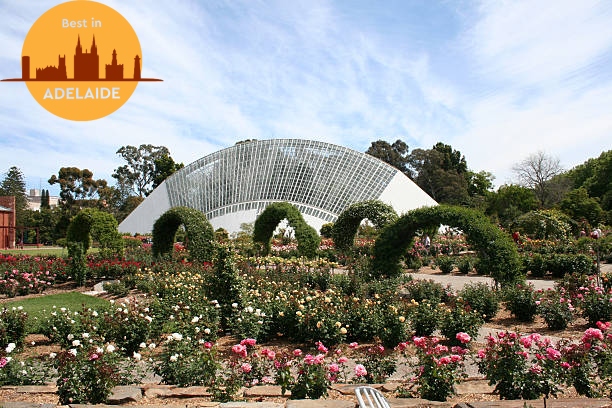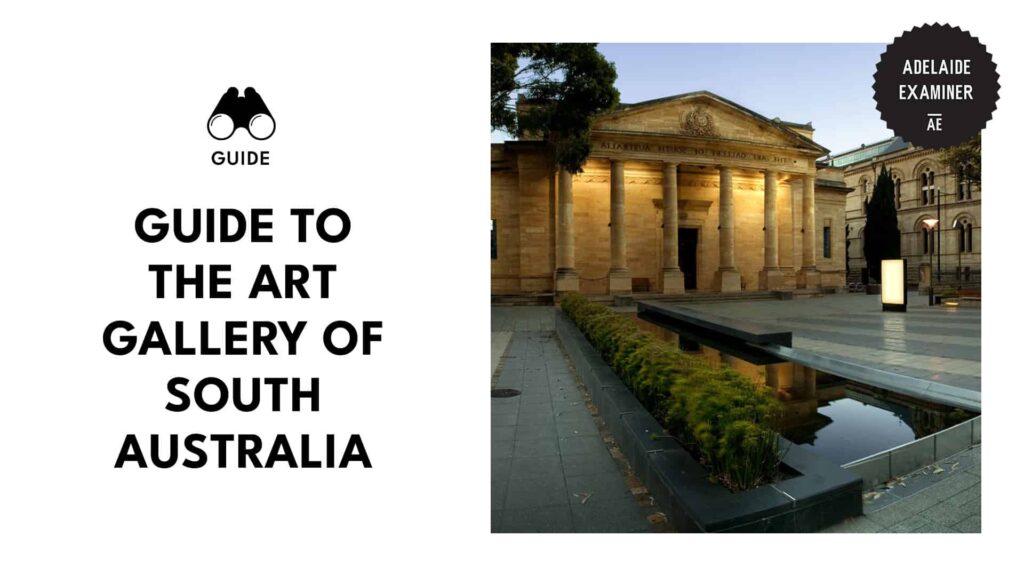
Paradise in Bloom: A Guide to the Adelaide Botanic Garden
- Planning Your Visit
- Adelaide Botanic Garden Location, Opening Hours, and Admission
- Fastest Ways to Get to the Adelaide Botanic Garden
- Adelaide Botanic Garden’s Parking Zones and Rates
- Important Regulations of the Adelaide Botanic Garden
- Visiting the Gardens
- The International Rose Garden
- Dahlia Garden
- Little Sprouts Kitchen Garden
- Australian Native Garden
- South Australian Water Mediterranean Garden
- Garden of Health
- Threatened Plant Seed Orchard
- Checking the Non-Garden Spots
- Amazon Waterlily Pavillion
- Bicentennial Conservatory
- Santos Museum of Economic Botany
- Simpson Shadehouse
- Diggers Garden Shop
- Palm House
- Eating at the Cafes and Restaurants
- The Gardens Kiosk
- Cafe Fibonacci
- Restaurant Botanic
- FAQs about the Adelaide Botanic Garden
The Adelaide Botanic Garden is a well-kept paradise in the center of bustling Adelaide. With over 50 hectares of land adorned by South Australia’s most magnificent flowers and plants, this place is perfect for appreciating Adelaide’s diverse flora.
Our team went to the Adelaide Botanic Garden and checked what it has to offer. From visiting ravishing gardens to relishing a cup of perfectly blended coffee, here’s our guide to the picturesque Adelaide Botanic Garden.
Planning Your Visit
Our team understands how stressful trip planning can get sometimes. To make your escapade to the Adelaide Botanic Garden hassle-free, we have researched and compiled the essential info you need for your trip.
Adelaide Botanic Garden Location, Opening Hours, and Admission
| LOCATION | North Terrace, Adelaide, Adelaide, South Australia, 5000 |
| OPENING HOURS FROM DEC TO MAR | CLOSING HOURS FROM DEC TO MAR |
| Mon to Sun: 7:15 amPublic Holidays: 7:15 am | Mon to Wed: 7 pmThu to Sun: 9 pmPublic Holidays: 9 pm |
| OPENING HOURS FROM APR TO SEP | CLOSING HOURS FROM APR TO SEP |
| Mon to Fri: 7:15 amWeekends: 9 amPublic Holidays: 9:am | Mon to Fri: 5:30 pmWeekends: 5:30 pmPublic Holidays 5:30 pm |
| OPENING HOURS FROM OCT TO NOV | ClOSING HOURS FROM OCT TO NOV |
| Mon to Fri: 7:15 amWeekends: 9 amPublic Holidays: 9:am | Mon to Wed: 6:30 pmThu to Sun: 7:00 pmPublic Holidays: 7:00 pm |
| ADMISSION | Free |
Fastest Ways to Get to the Adelaide Botanic Garden
| BY BUS | TRAVEL TIME AND FARE |
| Line 174 bus via 1 North Terrace – North Side | 15 to 20 mins ($3.21) |
| BY TRAM | TRAVEL TIME AND FARE |
| Pirie St Tram Stop to Adelaide Botanic Garden | 21 to 25 mins ($3.21) |
| BY TAXI | TRAVEL TIME AND FARE |
| Any taxi in the center | 5 to 10 mins ($9 to $11) |
Adelaide Botanic Garden’s Parking Zones and Rates
Please note that the parking fees listed in the table apply from 8 am to 6 pm.
| ZONE | MON-FRI RATE PER HOUR | SAT RATE PER HOUR | SUN AND PUBLIC HOLIDAY RATE PER HOUR | PARKING DURATION |
| Zones 1 and 6 of Plant Tree Drive | $3.80 | $0.70 | Free | 10 hours |
| Zones 2 to 5 of Plant Tree Drive | $3.80 or a flat fee of $10 | $0.70 | Free | 4 hours |
| 8 Goodman Building Car Park | $3.80 | $0.70 | Free | 4 hours |
| 7 State Herbarium Car Park | $3.80 or a flat fee of $25 | 4 hours ($3.80)10 hours ($25) |
Important Regulations of the Adelaide Botanic Garden
Here are the rules you must keep in mind if you’re planning to visit the Adelaide Botanic Garden.
- Dogs are not allowed.
- Flying drones are prohibited.
- Bringing/drinking liquor is not allowed.
- Visitors shouldn’t ride bikes, scooters, rollerblades, and skateboards.
- Strictly no smoking,
- Driving vehicles in the gardens is prohibited.
- Throwing games, stepping on garden beds, and other plant-damaging activities are not allowed.
Visiting the Gardens
Our team’s most recommended activity when visiting the Adelaide Botanic Garden is, of course, to check out the best gardens it offers.
From wetland flowers to fruit-bearing spots, here are our picks for this site’s best gardens!
The International Rose Garden

Let’s start your trip to the Adelaide Botanic Garden by visiting 2022’s Garden of Global Excellence Awardee!
The International Rose Garden is a very fragrant area that boasts over 350 specially cultivated roses and approximately 2,700 foreign and local rose varieties.
Floribunda Roses, Landscape Roses, and Tea Roses are the most common flowers you’ll see here.
This spot also has the National Rose Trial Garden which breeds rare roses that are not yet sold in the Australian flower market. We visited this trial garden, and we saw yellow, pink, and violet roses!
This circular and sunken garden also includes wonderful pergolas that serve as perfect resting spots. These pergolas are also great for photo ops, so much so that most of the pictures we took here used them as backdrops!
Additionally, there’s a breathtaking tunnel here embellished by rose arches. This tunnel is perfect for strolling, romantic dates, picture-taking, and self-reflection.
| Tip: It’s best to visit the International Rose Garden from October to November. The roses are in full bloom during these months. Additionally, the fragrance of the roses is at its best during summer mornings! |
Dahlia Garden

With flower-topped walkways to roam through, Adelaide Botanic Garden’s Dahlia Garden is an intimate and visually spectacular space encompassed by short, well-kept hedges.
The Franz Kafka Dahlia, a very pink pompom flower, is the most common kind of dahlia here.
Whenever we visit the Dahlia Garden, we always head to the area where Central and South American dahlias bloom. In our opinion, the dark purple, red, and light pink variants of these foreign dahlias are the most enthralling!
If you’re into combining dahlia varieties, you may check the part of the garden where modern-day dahlias grow. These decorative dahlias are the results of hybridization, and you’ll find instructions on how to grow them in this portion of the garden.
If you’re lucky like us, you may cross paths with members and volunteers of the Dahilia Society of South Australia during your visit here! They taught us the most important rule when it comes to growing dahlias: exposure to morning sunlight and afternoon shade!
| Tip: The best season to visit this garden is during summertime. The lushness, fragrance, and beauty of dahlias are at their peak during sunny days! |
Little Sprouts Kitchen Garden

The Little Sprouts Kitchen Garden is a colorful paradise located on the eastern side of the Adelaide Botanic Garden.
This area is amazing for children, as the gardeners growing fruits and herbs here will give lessons to kids about how plant-based food is produced!
This is our team’s favorite spot because of the several fun activities we did here. From group discussions inside a giant basket weave dome to playing with compost worms, we never got bored during our visit to this scenic spot.
We also interacted with interesting native bee hotels and climbing plants that intertwine on high structures!
The gardening activities we did on the garden’s working bench spaces and uniquely-shaped garden beds added a sense of challenge and adventure too!
For us, though, nothing beats the simple yet very gratifying feeling of handpicking the seasonal fruits and vegetables that are abundant in Little Sprouts Kitchen Garden.
Kale stalks, carrots, pumpkins, lettuce, and cherries are the most common ones you’ll find here!
| Tip: If you’re looking for a more thorough discussion about growing fruits and vegetables, we suggest enrolling in the sessions provided by the garden educators here! |
Australian Native Garden

The vibrant Australian Native Garden is an inventive and artistic place that maximizes the uses of native plants and flowers.
In this spot, our team witnessed Adelaide’s local flora being used in garden beds, hedging, screening vegetation, and pot-making!
The innovative utilization of the plants here is achieved because of the garden’s heritage stone wall and location.
The Australian Native Garden is in an area where different degrees of shade and sunlight are available, allowing the plants to develop in unique ways!
Our team also thinks that the Australian Native Garden is a very Instagrammable spot. With landscapes that make use of lush greenery and well-placed stone structures, this place has the aura and looks of a tropical paradise!
It’s also great to know that the landscape designs here are not just for show. One of the garden educators we talked to explained that the formations found in the garden are designed using principles and techniques that prioritize environmental sustainability.
For example, the rooves of the garden’s buildings are adjacent to the area’s irrigation system which directs rainwater to a 25,000-liter tank. Aside from the aesthetic quality of these structures, they also maintain the garden’s self-sustainability!
| Tip: We recommend checking the Australian Native Garden’s collection of Australian cultivars and hybrids! These unique and beautiful varieties are cultivated from the plant life of the Adelaide plains! |
South Australian Water Mediterranean Garden

The South Australian Water Mediterranean Garden is a watery garth that displays several plants picked from the world’s five Mediterranean regions.
During our visit here, we saw and learned about plants from South Africa, Cali, Chile, The Mediterranean Basin, and SW Australia!
The caretaker of the garden elaborated on how the Mediterranean plants here store water during periods of drought and make the most of rain when it does fall.
He also explained how scientifically important and rare these plants are because of their ability to survive in harsher conditions.
We even saw a rare white floret that belongs to the Cistus genus. It may have been small, but it has the jaw-dropping ability to germinate using wildfires!
| Tip: Always ask for assistance when handling the plants in this area. Aside from being rare, some of the plants here, like the deceptively normal-looking oleander from The Mediterranean Basin, contain a toxic sap! |
Garden of Health

As the name suggests, the Garden of Health offers a plethora of Eastern and Western healing plants as well as demonstrations on how to use them.
This garden has more than 2,300 foreign and local medicinal flowers belonging to 257 diverse species!
The keepers of this lively green space also helped our team learn how these plants changed over time, from the Neolithic era to modern pharmacology!
We also experienced a tour of the spot’s main sections: the Garden of Healing and the Garden of Contemplation!
If you’re looking for medicinal plants for the mind and body, the Garden of Healing is where you should go. With an abundance of beneficial plants from all seven continents, this spot’s great for educational strolls, relaxation, and discovery.
The Garden of Contemplation, on one hand, offers three garden beds with varying themes. These garden beds are created to promote the importance of socialization, healthy food, physical activities, self-reflection, and pleasure.
The three garden beds we explored in the Garden of Contemplation are the following.
- Orchard of Earthy Delight – a garden full of edible plants that are perfect for a healthy diet
- Garden of Mind’s Ease – a garden full of stimulating plants that alleviate stress, anxiety, and insomnia
- Tranquil Garden – a serene garden designed to reinvigorate the mind and senses through nature’s inspiring beauty
| Tip: In our opinion, the Garden of Health is the best place to end your tour in the Adelaide Botanic Garden because of how tranquil it is. You’d probably get exhausted from a day of exploration, so it would be beneficial for you to visit a garden that specializes in mental and physical rejuvenation. |
Threatened Plant Seed Orchard
The Threatened Plant Seed Orchard was added to the Adelaide Botanic Garden to prevent the extinction of vulnerable plant species by safely storing their seeds. Since this spot has endangered plants, we suggest visitors be cautious here.
The Limestone Phebalium is one of the critically endangered flowers we learned about in this orchard. It’s a pristine and sweet-scented flower with thin long petals that are snowy white, purple, or light yellow.
The keepers of the Threatened Plant Seed Orchard explained to us how critical plants like the Limestone Pheballium are to the environment and how their extinction could affect our way of life.
They also showed us their endangered seed collection which consists of rapidly decreasing plants from a single population. After that, they then educated us on how we could contribute to the cause of preserving them for future generations.
| Tip: Given the delicate status of the plants and seeds in this orchard, we suggest not bringing any substance that contains harmful chemicals. By doing this, you’re helping in the preservation of endangered plants and also saving yourself from potential questioning. |
Checking the Non-Garden Spots
Aside from gardens brimming with flowers and plants, the Adelaide Botanic Garden has eye-catching buildings and sweeping natural spots too.
From pampering pavilions to soothing shade houses, here are the best non-garden spots of the Adelaide Botanic Garden!
Amazon Waterlily Pavillion

The Amazon Waterlily Pavillion is an energy-efficient glass house with an architectural design that’s majorly inspired by the huge leaves of waterlilies. This spot’s centerpiece is a crystal-clear pond where enticing Victoria Amazonica Waterlilies float.
Our team really enjoyed visiting this place not just because of its modern and artistic design but also due to the said Victoria Amazonica Waterlilies. This rare lily naturally grows in the Amazon River’s tributaries in South America!
Additionally, inside the pavilion is where we found an informative gallery that showcases the waterlily’s distinctive shape and biology through pictures and artwork. This gallery also displays the waterlily’s cultural and symbolic value.
We also took tons of pics of bromeliads, orchids, and begonia that surround the landscapes just outside of the gallery! For us, though, the best feature of this pavilion is how beautiful and interesting it becomes during the night.
When nighttime arrived, we saw how the waterlilies opened up and attracted beetles using the fragrance of their petals.
Once the beetles landed on the waterlilies, they trapped them by closing their white petals. Totally fascinating!
| Tip: Between September and April is the most ideal time to view the magnificent Victoria Amazonica Waterlily. |
Bicentennial Conservatory
The Bicentennial Conservatory is the biggest single-span conservatory in the Southern Hemisphere. This structure is 47 meters wide, 100 meters long, and 27 meters high!
It was constructed in 1988 and designed by the well-respected South Australian architect, Guy Maron. Moreover, with glass walls and doors, this curvilinear conservatory boasts a design that’s very attractive to visitors.
This spot got even better once we went inside where we found a display of healthy rainforest plants that came from nearby Pacific islands! The temperature in this area is very cool, and the earthy aroma of the plants is worth noting too!
The Bicentennial Conservatory’s ecology where lowland rainforest vegetation and a vast canopy of trees is also visually spectacular! This area has rare and endangered plants from Indonesia, Papua New Guinea, and Australia!
| Tip: The Bicentennial Conservatory is great for visitors who are traveling with their families. Its sheer size and collection of engaging biomes make it an engrossing tourist destination for families! |
Santos Museum of Economic Botany
From gracialouise
The Santos Museum of Economic Botany is the last institution of its kind in the entire world. This museum is the home of an incredible permanent collection of plant models and art installations that were first exhibited 140 years ago!
This gem in the Adelaide Botanic Garden made us travel back in time. The colonial design of the museum itself made us feel like we were in a different era!
The museum’s main attraction, however, is its collection of models of different types of plant life. Here are some of the most celebrated pieces that the museum holds.
- Fungi Model Showcase – a collection of 210 paper mache models that details the growth stages of fungi
- Grove – a cabinet of artworks made by Fiona Hall that represents the connection between nature and culture
- Seaweeding – a collection of art installations made using marine organisms
- Fruit Mode Showcase – a collection of German-crafted paper mache models of fruits that were mainly used to educate farmers in the 19th century
| Tip: The museum doesn’t require any entrance fee or any pre-booking shenanigans, but you have to visit it early if you want to discover the entirety of the permanent collection. At 4 pm, the Santos Museum of Economic Botany will close so you have to be mindful of the time. |
Simpson Shadehouse
With an elegant veranda, shady garden, and wide outdoor area, the Simpson Shadehouse is an ideal spot for playing and relaxing.
This place was first opened to the public in 1919 and is still standing as one of Australia’s finest spots for breathers and getaways.
The shade house’s design incorporates bush-house and inter-war structures that provide a perfect amount of shade.
Aside from the house, the tropical rainforest surrounding the manor also added to the cool climate. It was summer when we went to this spot, but the house’s coolness made us forget about the hot season!
The Simpson Shadehouse also has a wide variety of botanical plants, including tree ferns, Rhapis palms, camellias, begonias, hydrangeas, fuchsias, Platycerium, and Pteris!
| Tip: We strongly suggest taking pictures in the Simpson Shadehouse. With the tropical rainforest as your background, your pics will be breathtaking! |
Diggers Garden Shop
If you’re looking for comprehensive guides and lessons on how to cultivate a garden, Diggers Garden Shop is the place where you should go to.
The gardeners in this shop offer expertly designed workshops and masterclasses about growing fruits, vegetables, and more!
This is where you may also join the National Diggers Club. Joining this association comes with amazing perks such as seasonal magazines about planting, gardening products sold to members only, and huge discounts on seeds, bulbs, crops, and more!
If you’re not planning to enter the club, you’ve got nothing to worry about, as non-members can still shop for heirloom seeds, gardening tools, plant-based souvenirs, and instructional books.
We purchased a book about vegetable cultivation in this shop and learned a lot!
| Tip: If you plan on visiting the Diggers Garden Shop, make sure to ask the vendors if they have old varieties of vegetables that are no longer sold in mainstream markets. |
Palm House
The Adelaide Botanic Garden’s Palm House is an exquisitely restored glass mansion that was imported in 1875 from Bremen, Germany. It holds a collection of Madagascar flora that thrives in a warm and dry ecosystem.
Designed by the legendary German architect, Gustav Runge, the Palm House was built using sophisticated techniques that are still used by modern-day constructors of glass houses.
This stunning piece of architecture looks like it came straight out of a fairytale. When we first saw it, we almost couldn’t believe that it was real!
Its beauty is elevated during sunny days when the glass walls dazzle with the sun’s rays!
| Tip: Taking a picture in front of the Palm House has almost become a tradition for visitors of the Adelaide Botanic Garden. Make sure to capture the golden moment by posing in front of this fantastic structure! |
Eating at the Cafes and Restaurants
If you ever get hungry while scouring the botanic garden, these are the eateries where you can feast on delicious and filling meals!
The Gardens Kiosk
With a giant oak tree providing shade, The Gardens Kiosk is an alfresco, family-friendly restaurant surrounded by lush environments. The menu they serve here consists of French pastries and complete picnic boxes (this one must be pre-ordered).
Our favorite part about The Gardens Kioks is its casual vibe. When we ate in this cozy spot, we felt at home and stress-free.
The sweet delights they served us were buttery, cream-filled, and very soft. The artisans making them also informed us that the hand-baked pastries are only prepared when a customer orders.
They also only use seasonal ingredients that are produced locally, ensuring the freshness and quality of their meals.
| Tip: We suggest eating at The Gardens Kiosk in the morning, preferably before you start touring the Adelaide Botanic Garden. It’s technically open from 8:30 am to 4 pm, but we think that the meals they serve here are best consumed in the morning. |
Cafe Fibonacci
Cafe Fibbonaci is a casual dining place that’s situated in the South Australian Water Mediterranean Garden. This cafe provides a selection of tasty meals and drinks that include pastries and aromatic coffee.
It also has a selection of picnic baskets that you can pre-order. These picnic baskets include the following selections: vegetarian box, vegan box, gluten-free box, and gourmet box.
Aside from the food, the view in this cafe is also wonderful. With the South Australian Water Mediterranean Garden nearby, you’ll get to see nature at its finest while enjoying your hearty meals and satisfying drinks.
| Tip: Just like The Gardens Kiosk, the best time to eat at Cafe Fibonacci is in the morning. |
Restaurant Botanic
The award-winning Restaurant Botanic is an open-kitchen eatery that provides a welcoming ambiance, premium beverages, and high-quality food. With a vibrant garden encompassing the garden’s area, this place is surrounded by fresh air.
The executive chef of this restaurant is Justin James, an internationally renowned cook who specializes in preparing memorable and creative meals. According to him, the food in his restaurant will provide a “sensory escape.”
Restaurant Botanic offers meals and drinks that are made from fresh ingredients bought from local farmers too. Chef James even said that he only uses ingredients that are “as close to perfect as they can be.”
You may also order cocktails and wines in this restaurant. These finely crafted beverages are prepared in the open bar area near the garden.
| Tip: Bookings are required in the Restaurant Botanic. If you’re planning to dine here, make sure to visit their website or contact them first. |





